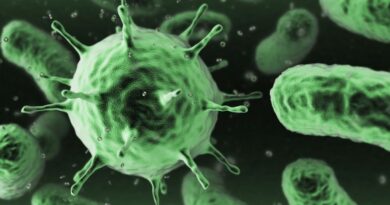NHS, emergency services and public health have always known covid and its vaccine are bioweapons; it’s stated in their CBRN guidance
For more than a decade all emergency services, primary care and public health staff in England have known coronaviruses do not naturally occur and are bioweapons; yet they have been and still are permitting, if not encouraging, them to be injected into people en masse since the rollout of the covid vaccines.
Public Health England guidance on Chemical, Biological, Radiological, and Nuclear (“CBRN”) threats that date back to 2008 has surfaced which states: “Human coronaviruses do not currently occur naturally in the UK … The first highly pathogenic human coronavirus diseases emerged in 2003 (SARS coronavirus) … SARS was first identified in Southern China in late 2002.”
Last year, Dr. David E. Martin said, “Since 2002, there has not been a coronavirus; there has been an engineered pathogen. Engineered by Ralph Baric at the University of Carolina Chapel Hill where, in 2002, he patented the’ infectious, replication defective, clone of coronavirus’.”
Let’s not lose touch…Your Government and Big Tech are actively trying to censor the information reported by The Exposé to serve their own needs. Subscribe now to make sure you receive the latest uncensored news in your inbox…
Democracy Manifest has highlighted a 2018 document published by Public Health England. Public Health England (“PHE”) was replaced by the UK Health Security Agency (“UKHSA”)and the Office for Health Improvement and Disparities, which were formed on 1 April 2021 and 1 October 2021 respectively.
Titled ‘Chemical, biological, radiological and nuclear incidents: clinical management and health protection’, the document is guidance to be followed by health care professionals in emergency departments, primary care and public health. It is also guidance for emergency planners and trainers, and emergency service personnel. Originally published in September 2008, the document was last updated on 31 May 2018.
Democracy Manifest, a group that is in search of the origins of the covid-19 response, highlights information within the guidance that they feel is relevant specifically to covid. You can read Democracy Manifest’s article HERE. In the following, we are exploring what evidence it contains that indicates SARS-CoV-2 was, from the outset, known to be a Chemical, Biological, Radiological and Nuclear (“CBRN”) threat by UK authorities.
As the document is guidance for incidences of CBRN threats. Let’s first remind ourselves what a CBRN threat is and also to check whether the definition of CBRN has changed in recent years. To do this we did a quick internet search and trusted that the most recent information that matched our queries were returned. If you are confident in what a CBRN threat is, you can skip this section.
Table of Contents
CBRN Threats
CBRN threats are significant security concerns that can cause severe harm to public health, infrastructure and economies. These threats can arise from accidents, poor safety measures, or malicious actors and include the use of chemical, biological, radiological, and nuclear materials or weapons.
Read more: A quick guide to CBRN threats, response, and solutions, Risk Aware
CBRN Threats UK
CBRN threats in the UK involve the malicious use of chemical, biological, radiological, or nuclear materials or weapons with the intention to cause significant harm or disruption.
Read more: Chemical, Biological, Radiological and Nuclear (CBRN) Threats, National Protective Security Authority
The UK has established various measures to mitigate CBRN risks, including the development of training and equipment capabilities for emergency services and military personnel. The NHS has streamlined its guidance for the initial management of self-presenters from incidents involving hazardous materials, incorporating the Initial Operational Response (IOR) programme developed by the Home Office.
Read more: Hazardous Materials (HAZMAT) and Chemical, Biological, Radiological and Nuclear (CBRN), NHS England, 1 February 2022
In addition to the NHS, the UK has a network of organizations and initiatives aimed at enhancing CBRN risk mitigation. These include the European Union (“EU”) CBRN Risk Mitigation Centre of Excellence (“CoE”), which brings together over 60 countries to strengthen CBRN risk mitigation and promote a global culture of safety and security.
Biological CBRN threats noted by the EU CBRN Risk Mitigation are, “Avian flu, the Ebola outbreak in West African countries, Dengue fever, Zika virus, zoonotic diseases or the ongoing Covid-19 pandemic.”
The EU CBRN Risk Mitigation diverges from other definitions of CBRN threats in that it notes they are dual purpose, both a threat and a benefit:
“The acronym ‘CBRN’ defines chemical, biological, radiological and nuclear materials and agents that could potentially harm the society through their accidental or deliberate release, dissemination, or impacts. Nowadays many of these agents have been subject to innovative practices in medicine, agriculture and industry and are being used for the benefit of human health, the environment and the global economy.”
Read more: Chemical, Biological, Radiological and Nuclear Risk Mitigation, European Union
CBRN Clinical Management
The following is an artificial intelligence (“AI”) summary as of 6 February 2025 for the query “Chemical, biological, radiological and nuclear incidents: clinical management and health protection,” which is the title of the 2018 guidance from Public Health England. Please note that AI is simply a computer programme and can, and does, make errors.
Chemical, biological, radiological, and nuclear (“CBRN”) incidents require a comprehensive approach to clinical management and health protection. Immediate actions include decontamination procedures, which vary based on the severity of the exposure. For instance, severe exposures may require stretcher decontamination and life-saving interventions, while less severe cases might involve walking decontamination procedures.2
Health impacts from CBRN hazards can range from immediate sickness and injury to long-term serious illness and death. These effects can be exacerbated by adverse psychological reactions due to uncertainty about the extent or effects of exposure. Some of the main causes of mortality from CBRN include multi-organ failure, respiratory failure and neurological events such as seizures, coma and stroke.1
In terms of clinical management, specific treatments are necessary for different types of exposures. For example, nerve agent exposure might require fitting or atropine treatments, while cyanide poisoning might need a combination of atropine and other antidotes.2
Health protection strategies include community engagement and education on prevention of exposure through contaminated food, land or water. Ensuring safe water, food and fuel supplies is crucial to prevent people from accessing contaminated areas to meet their basic needs. Additionally, moving at-risk populations to safe zones and providing sanitation facilities can help prevent exposure.1
The NHS England’s Initial Operational Response (“IOR”) programme was introduced to improve patient outcomes following contamination with hazardous materials or CBRN incidents. This programme is applicable to NHS settings that may expect to receive ambulant self-presenting patients following an incident.3
Health authorities also develop specific plans and clinical guidelines for responding to CBRN incidents, including the management of biological agents that could be used in bioterrorist acts. These plans cover recovery arrangements and aim to effectively coordinate a national health response to incidents of national significance.4
The risk of CBRN incidents is considered to be changing globally due to advances in technology and the increased likelihood of terrorists using unconventional weapons. Preparedness for these threats involves assessing risks and developing strategies to mitigate potential harm.5
In summary, managing CBRN incidents involves a combination of immediate clinical interventions, long-term health protection strategies and comprehensive preparedness plans to address the diverse health impacts of these hazards.1,2,3
- [1] Chemical, biological, radiological and nuclear (CBRN) hazards, International Federation of Red Cross and Red Crescent Societies, 8 October 2023
- [2] Bland SA. Chemical, Biological, Radiological and Nuclear (CBRN) Casualty Management Principles. Conflict and Catastrophe Medicine. 2013 Jul 18:747–70. doi: 10.1007/978-1-4471-2927-1_46. PMCID: PMC7121337.
- [3] Hazardous Materials (HAZMAT) and Chemical, Biological, Radiological and Nuclear (CBRN), NHS England, last updated 1 February 2022
- [4] Chemical, biological, radiological or nuclear health response, Department of Health and Aged Care, Australian Government, last updated 2 November 2022
- [5] UKHSA Advisory Board: preparedness for chemical, radiological and nuclear threats, UK Government, 14 March 2023
- [6] Calder A, Bland S. Chemical, biological, radiological and nuclear considerations in a major incident. Surgery (Oxf). 2015 Sep;33(9):442-448. doi: 10.1016/j.mpsur.2015.07.006. Epub 2015 Aug 6. PMID: 32287820; PMCID: PMC7143674.
Dual Purpose CBRN Agents
From the descriptions above it is clear that a CBRN incident is a deliberate or accidental release of chemical, biological, radiological and nuclear materials or weapons.
The European Union recognises the dual purpose or dual use of CBRN agents in its definition. In respect of biological CBRN agents, dual use means that biodefense and biowarfare are two sides of the same coin, which allows for biowarfare research to be conducted under the guise of biodefence.
Dual use has particular relevance to biological agents such as the novel coronavirus SARS-CoV-2 that is said to cause the set of symptoms labelled as the disease covid-19.
As Dr. Harvey Risch explained during a roundtable discussion led by US Senator Ron Johnson last year, “The covid-19 pandemic virus exists because it was bioengineered.”
[The] bioweapons industry [ ] has been performing secretive and nefarious biological weapons development for the last 70 years.
The recognition of the possible accidental or intentional unleashing of an infectious agent capable of killing large numbers of humanity led to the Bioweapons Treaty of 1975.
The Treaty prohibits the development of offensive bioweapons. However, the one loophole in the Treaty is that small quantities of offensive bioweapons are allowed to be developed in order to do research on vaccine countermeasures.
Now, this loophole was then exploited by our bioweapons industry for the last 50 years. The Bioweapons Treaty limited offensive bioweapons to agents that would address vaccine development – so-called dual-use agents or dual-use research.
Covid origins and that vaccines were unsafe and ineffective were covered up to protect the integrity of the bioweapon industry, Dr. Harvey Risch says, The Exposé, 14 March 2024
For years, Dr. David E. Martin has been warning the world that SARS-CoV-2 is a man-made bioweapon. And it’s not only SARS-CoV-2. He says that all coronaviruses for more than 20 years have been man-made. “Since 2002, there has not been a coronavirus; there has been an engineered pathogen. Engineered by Ralph Baric at the University of Carolina Chapel Hill where, in 2002, he patented the’ infectious, replication defective, clone of coronavirus’,” he said during an interview with Alex Jones last year.
During a lecture in Switzerland in 2023, Dr. Martin said that the “coronavirus” virus was first described in 1965. Two years later, healthy British military personnel were infected with coronavirus pathogens from the US “as part of our biological weapons programme.”
Alluding to the “dual use” of coronavirus research, Dr. Martin said, “The covid injections were 19 years in the making by the time they were rolled out. These injections were rolled out despite the mRNA spike protein being publicly referred to as a bioweapon almost 20 years ago. In 2005, the mRNA spike protein was presented at a conference organised by DARPA and Miter Corporation as a ‘technology that enables biological warfare’.”
Public Health England CBRN Guidance
PHE’s guidance on biological agents begins on page 68 of its 2018 document titled ‘Chemical, biological, radiological and nuclear incidents: clinical management and health protection’.
Biological agents may be deliberately released covertly or overtly, the guidance states. “This manual focuses on organisms that could be aerosolised and/or would cause serious or fatal infections.”
In PHE’s CBRN guidance, “coronavirus” is mentioned 22 times including four mentions of “novel coronavirus.”
On page 90, PHE’s guidance lists key facts about novel coronaviruses. The first two facts in the list are: “The first highly pathogenic human coronavirus diseases emerged in 2003 (SARS coronavirus)” and “human coronaviruses do not currently occur naturally in the UK.”
Another key fact PHE gives is: “SARS was first identified in Southern China in late 2002.”
These key facts are not new to PHE’s guidance. This has been the case since the guidance was first published in 2008. Under key facts for severe acute respiratory syndrome (“SARS”), the 2008 guidance stated: “Caused by a human coronavirus discovered in 2003, SARS coronavirus does not occur naturally in the UK” and “first cases were seen in Southern China in late 2002.”
Remember what Dr. Martin said? He said, “Since 2002, there has not been a coronavirus; there has been an engineered pathogen.”
When SARS-CoV-2 was first announced to the world it had not yet been given a specific nomenclature. It was widely referred to as a “novel coronavirus.” In January 2020, the World Health Organisation (“WHO”) recommended naming the novel coronavirus 2019-nCoV. “nCoV” is an abbreviation for “novel coronavirus.” The official name SARS-CoV-2 was issued by WHO on 11 February 2020.
Anyone in the UK who was familiar with, or had even read, PHE’s CBRN guidance in the previous 10 years knew that the novel coronavirus, now known as SARS-CoV-2, is a bioweapon. That means healthcare professionals in emergency departments, primary care and public health, emergency planners and trainers, and emergency service personnel in England knew from the outset that SARS-CoV-2 was a bioweapon.
Worse than that, they ALL KNEW from the outset, before any injections were given to the public, that the “vaccine” is also a bioweapon. The “vaccines” against SARS-CoV-2 were widely publicised as containing the genetic sequence of the bioweapon’s spike protein, which is the disease-causing agent of the coronavirus bioweapon.
All the covid vaccines have been designed to introduce the SARS-CoV-2 spike protein bioweapon into recipients’ bodies. mRNA vaccines, such as Pfizer-BioNTech and Moderna, include genetic material in the form of messenger RNA (mRNA) that instructs the body’s cells to produce the spike protein. Protein-based vaccines, such as inactivated whole-virus vaccines and subunit vaccines, contain the spike protein directly rather than genetic instructions for its production. AstraZeneca, an adenoviral vector vaccine, used a modified chimpanzee adenovirus to deliver the genetic instructions for the SARS-CoV-2 spike protein. Janssen uses a modified human adenovirus to deliver the gene for the SARS-CoV-2 spike protein into cells.
In the following, we use Moderna as an example to give a more detailed description of how the vaccine bioweapon was designed before they were released on the public.
On 18 December 2020, Stéphane Bancel, CEO of Moderna, described in an interview how his company designed a vaccine against the novel coronavirus (SARS-CoV-2) on a computer (in silico) in just two days. Bancel and his team were able to design the vaccine in just 48 hours after receiving the digital sequence of the virus from China. “We thought it up in silico, we never had access to a physical virus,” he said in an interview a few months later.
Moderna’s approach involved designing the vaccine to produce the full-length spike protein of the virus inside human cells, mimicking a natural infection. Moderna’s covid-19 mRNA vaccine instructs the recipient’s cells to make a viral protein called a spike protein. This spike protein is the bioweapon as mentioned above.
During a panel discussion at the World Economic Forum (“WEF”) annual meeting in 2023, Bancel revealed that before a novel coronavirus pandemic had been declared, he had told his staff that Moderna were going to need to make 1 billion doses of the company’s “vaccine.”
WHO declared the coronavirus outbreak a pandemic on 11 March 2020. At the time, there had been nearly 4,291 deaths worldwide attributed to the virus, according to WHO.
Yet in late 2019 or early 2020, when worldwide deaths attributed to SARS-CoV-2 were even more insignificant, Bancel said to the WEF audience, “I remember walking after that into the office of Moderna manufacturing and I say: “How we make a billion doses next year?” And [you/they] look at me a bit funny say: “What?” I said: “Yeah we need to make a billion doses next year, there’s going to be a pandemic.”
What can we take away from all of this? They unleashed their bioweapon into the world by calling it a vaccine and injecting it into billions of people, and England’s health care, public health and emergency services are complicit.
Related:
Featured image: Adapted from ‘CBRN incidents: clinical management & health protection’, Health Protection Agency, Public Health England, 2008




